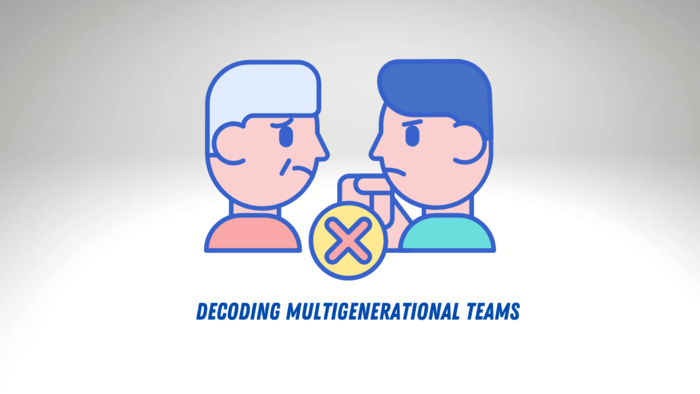Taking Steps to Promote Access and Equity for National Disability Employment Awareness Month 2023
Image Description: A diverse group of employees sit at a small round table with laptops open and computer monitors sitting on the top of the table. Charts and graphs are visible on the screens of the various devices. The two women sit beside a man in a wheelchair as the three employees are deep in discussion.
By Marion Davis
Each October, the US Department of Labor (DOL) recognizes National Disability Employment Awareness Month. For 2023, the DOL will be focusing on the theme of “advancing access and equity” for disabled professionals during this year’s National Disability Employment Awareness Month campaign.
While the celebrations in October are meant to raise awareness, employers should apply this awareness year-round with strategies for promoting access and equity within organizations to include professionals with disabilities in the workforce.
The DOL website provides many helpful tips for celebrating National Disability Employment Awareness Month with a particular emphasis on offering mentorship opportunities and creating newsletters with information on inclusion. Additional resources to include are employee resource groups managed by disabled employees within the organization. The organization can allocate a budget for these employees to secure resources and explore options such as professional speakers to provide organizational education.
Providing Mentorship Opportunities for Professionals with Disabilities
Within National Disability Employment Awareness Month, the third Wednesday of October is Disability Mentoring Day.
Mentoring is a valuable tool within organizations for harnessing the power of organizational knowledge and creating opportunities for knowledge transfer to historically underrepresented groups.
Senior leadership within corporations may feel that they cannot provide adequate mentorship to professionals with disabilities due to lack of awareness of disability culture across all employees. This need to increase awareness is an excellent opportunity to retain disabled contractors to provide sensitivity training for mentors. The research shows mixed results on whether same-identity mentors provide mentees with better outcomes. Regardless, sensitivity training is typically helpful for all members of a membership program in order to promote psychological safety.
Are Same-Identity Mentors the Best Approach?
While there are discussions on psychological safety and a perceived higher level of safety with same-identity mentors, the reality is that mentors of all backgrounds can potentially help mentees progress in their professional careers in various ways.
Studies have indicated that mentees being placed with same-identity mentors can have mixed results based on desired outcomes. The pool of white male senior mentors is larger within the workforce and this often results in cross-identity mentoring.
As several examples of cross-identity versus same-identity mentors, some research studies have indicated that women paired with male mentors tend to earn more financially while women paired with other women gain more “psychosocial support.” For youth mentoring, one organization found that same-race mentoring is typically perceived as more effective but that the measurable outcomes of same-race or cross-race mentoring were similar.
Using a Mix of Mentors from a Variety of Backgrounds for Disabled Mentees
Arguably, a variety of mentors all contributing to disabled mentees’ experiences within the workplace might be most beneficial. Having same-identity mentors can create a safe place within the workplace with shared experiences. However, at the same time, cross-identity mentors can push mentees outside their comfort zones in a beneficial way.
Contracting Speakers and Consultants with Disabilities
The month of October presents an excellent opportunity for corporations to contract with speakers who can educate employees on effective inclusion from a mix of professional and lived experience.
As an important note, with National Disability Employment Awareness Month, many disabled professionals report on social media platforms that organizations reach out to them and ask these professionals to speak for free. This is a common request that people from marginalized groups encounter, and such a request devalues the work of historically underrepresented groups.
Many disabled professionals who provide education to organizations have excellent track records for guiding companies in increasing their talent pool, improving disabled employee retention, and creating a positive culture that supports employee creativity and innovation. These results offer great value to an organization, and disabled speakers need to be paid accordingly. This is one way in which an organization can contribute to equity as part of this year’s National Disability Employment Awareness Month theme.
Promoting Access to Job Opportunities
Access is the other half of this year’s theme in disability employment awareness.
During the pandemic, with the increase in remote jobs, the employment rate for disabled professionals rose to a historic high of 21 percent. However, with the 2023 push for a return to the office, this historic progress may be undermined.
Considering that the disabled population makes up more than 25 percent of the US population, companies wishing to increase their talent pool should evaluate their hiring, onboarding, and employment processes to ensure that these processes are accessible.
Accessibility in Interviews
Providing multiple options for interview formats such as written interviews, audio-only interviews, and video interviews increases access across disability. For any synchronous interviews, to avoid any surprise questions and to practice mutual respect for time, organizations can send over the interview questions in advance.
Accessibility in Onboarding
Setting up onboarding activities such as being on-camera for training for four weeks from 9-to-5 will automatically eliminate many qualified professionals. For example, rigid requirements like these can create a barrier for individuals with a physical disability that prevents them from being upright for extended periods of time. On the other hand, some disabled professionals may appreciate being on camera and find this more accessible. The solution is to have alternative options prepared to support access for diverse talent and the willingness to respond to individual needs. Effective onboarding often sets the tone for employees’ experiences and performance later within the organization.
Accessibility in Day-to-Day Operations
Once employees have been onboarded, access within the workplace can continue to be an ongoing battle. A non-inclusive culture can reduce employee retention numbers. Additionally, requirements like frequent mandatory meetings can also restrict access for disabled employees who may need to work on a more flexible schedule. With the push still that cameras be on during meetings, this can add another layer of anxiety for disabled employees based on their disability.
Using Accessibility to Evaluate Internal Efficiency
The key within each of these areas is flexibility. While some organizations may maintain access barriers due to a resistance to change, other organizations can recognize that the diverse working styles of their talent provide an opportunity to re-evaluate operations.
With inflexible thinking, at times, corporations push back against anyone who is unable to match their cookie-cutter ideal for an employee at their organization. These corporations tend to view the need for accommodations in a negative light.
However, forward-thinking corporations can recognize that a diverse talent pool with a range of accommodations can provide companies with valuable insight into how to improve internal efficiency. Are those meetings truly necessary? Is there a better way to communicate? Disabled employees often introduce innovative and efficient ways of completing tasks.
Creating Employee Resource Groups
One powerful way for organizations to promote access and equity for disabled professionals during National Disability Employment Awareness Month and beyond is by establishing employee resource groups. Employee resource groups are voluntary, employee-led groups that bring together individuals with shared experiences, backgrounds, or interests.
There are several steps that organizations can take to create and leverage employee resource groups to support disabled employees.
Establish Disability Employee Resource Groups
Organizations can start by creating employee resource groups specifically focused on disability inclusion. These groups can provide a safe and supportive space for disabled employees to connect, share experiences, and discuss relevant issues. Again, it is important to recognize the value of blending safe spaces for disabled employees to support each other, cross-identity mentoring to give disabled professionals an opportunity to step outside their comfort zones, and whole-organization training on disability culture and topics.
Promote Intersectionality
As the largest minority group in the US, people with disabilities have a wide range of diverse identities and experiences. Corporations can encourage employee resource groups to be inclusive of all intersections, such as race, gender, sexual orientation, and more. Disability employee resource groups can emphasize inclusivity of intersectional identities by coordinating hybrid events with other resource groups. This intersectional approach can promote a deeper understanding of the unique challenges faced by disabled individuals with various backgrounds. The opportunity provided by the National Disability Employment Awareness Month is one where employee resource groups can promote awareness of disability culture and history as another layer of intersectionality.
Advocate for Accessibility
Disability employee resource groups can advocate for accessibility improvements within the organization. These groups can collaborate with management to identify and address barriers in the workplace, from physical accessibility to digital accommodations. However, corporations must make sure that there is an open line of feedback here with proactive responses to this feedback so that disabled professionals are not compelled to take on a large burden outside of their work tasks for basic accessibility needs.
Create Educational Initiatives
Employee resource groups can serve as a platform to educate both employees and leadership about disability awareness and inclusion. Corporations can provide disability employee resource groups with a budget to bring in professional speakers and consultants on disability issues so that none of the employees feel that they must shoulder this additional responsibility. Members of disability employee resource groups can utilize this budget to organize workshops, training sessions, and awareness campaigns to address any issues and develop a more inclusive workplace culture.
Offer Mentoring and Support
Disability employee resource groups can develop mentorship programs that pair disabled professionals with a range of mentors. A well-rounded approach should be used with both peer mentors and senior-junior mentors as well as same-identity and cross-identity mentorship opportunities to provide mentees with both the social support and knowledge transfer needed for advancement. These mentorship initiatives can help disabled mentees navigate their careers, build confidence, and access valuable insights. National Disability Employment Awareness Month can be the ideal launch time for disability-inclusive mentorship programs.
Celebrate Achievements
To challenge misconceptions, employee resource groups can recognize and celebrate the contributions and achievements of disabled employees within the organization. Many disabled employees themselves may not be aware of the statistics that put in quantitative terms the value that these employees bring to an organization. For instance, in one 2007 study at a Walgreens distribution center that had more than 30 percent disability representation, the center proved to be 20 percent more efficient than other Walgreens centers with fewer disabled workers. Working with people operations and human resources departments within organizations, employee resource groups can utilize company-specific statistics on performance related to disability representation and highlight success stories and showcase the positive impact of disability inclusion initiatives.
Final Thoughts
National Disability Employment Awareness Month urges organizations to prioritize year-round initiatives. In 2023, the focus for this year is the promotion of access and equity for disabled professionals. This month shines light on the importance of diverse mentorship programs, advocacy for fair compensation of disabled speakers, and the evaluation of hiring processes for increased accessibility. Additionally, employee resource groups emerge as pivotal tools, promoting intersectionality and advocating for accessibility improvements. Employee resource groups can lead educational initiatives, offer mentorship, and celebrate the achievements of disabled employees. Highlighting access and equity is not just a moral obligation but a strategic move for organizations seeking a diverse and talented workforce. National Disability Employment Awareness Month serves as a catalyst for lasting change, urging companies to move beyond awareness to tangible actions in creating inclusive workplaces.
Marion Davis is a contributing writer at EmployDiversityNetwork.com. She is a disabled DEIA consultant and writes on the value of diversity and inclusion across multiple industries, specifically as relates to disability and intersectionality.















